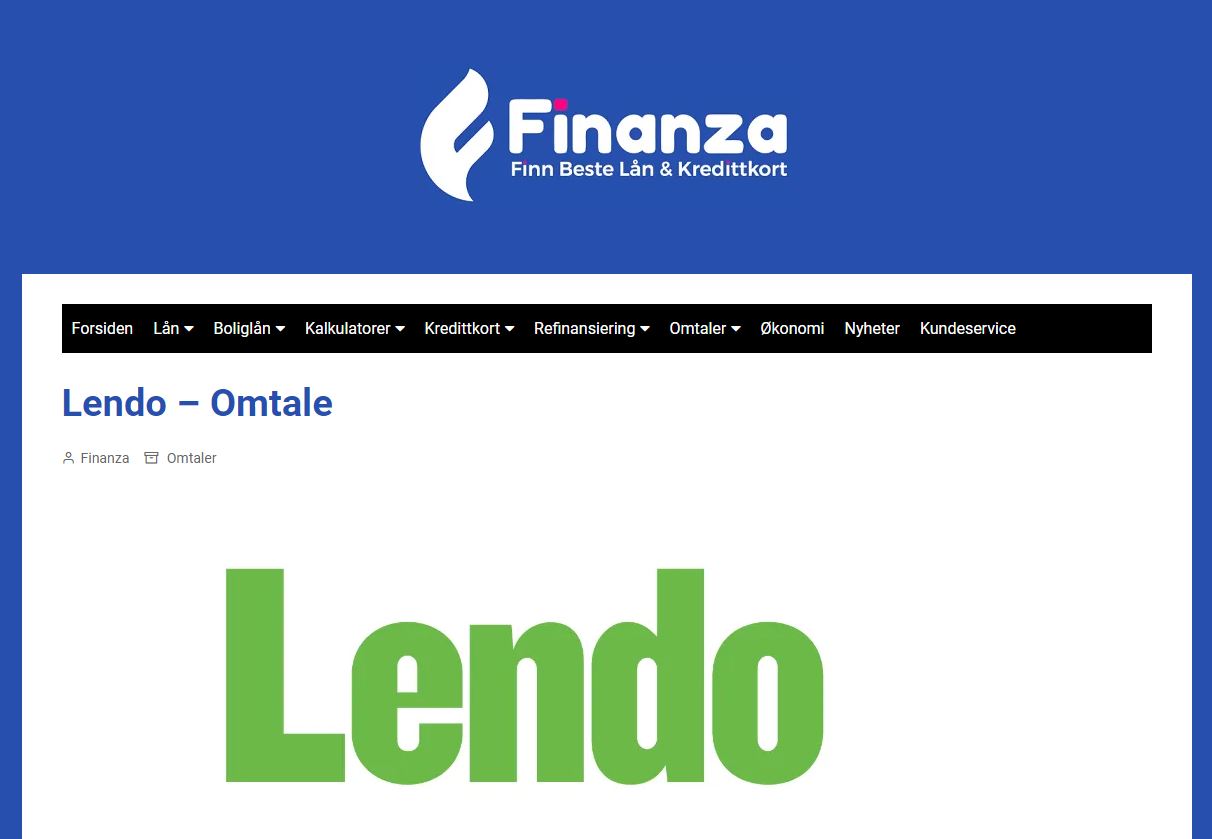
Types of Loans Available Through Finanza
If you’re looking for a loan agent in Norway, you need to look for an agency that will be able to offer you a variety of loans. From fixed rate to floating rate and covered bonds, there are several types of loans available. You can read more at Lendo – Omtale – Hva sier kundene? ~ Finanza.no.
Secured Loans
Secured loans are one of the most common ways to borrow large amounts of money. These are loans that are secured with collateral, such as a home or other asset. The lender puts a lien on the asset, which allows the lender to repossess the property if the borrower fails to repay the loan.
Secured loans are often better than unsecured loans. Because a security is backed by an asset, the lender is less likely to lose money if the borrower fails to pay. However, a secured loan still requires interest. Getting a secured loan is easier than an unsecured loan. You can qualify for a loan with bad credit, and you may be able to get a lower interest rate. In addition, if you are self-employed, a secured loan is typically easier to obtain than an unsecured one.
When considering a secured loan, it’s important to consider your financial situation. This includes your income, debt obligations, and credit history. It also helps to compare the requirements of different lenders. While every lender has their own guidelines, most follow similar procedures for approving loans. The interest rate for a secured loan can vary depending on the type of loan. Some have fixed rates, while others have variable rates. Regardless of the lender, you should make sure to shop around for the best rate.
Borrowers who are considering secured loans should read the terms carefully. Failure to repay a secured loan can negatively affect your credit rating.
Unsecured Loans
Unsecured loans are financial products that are approved without the need of collateral. They are usually available from banks or credit unions. These loans may be revolving or fixed. You can also obtain a loan from a peer-to-peer lender, who originates loans from individual investors.
However, unsecured loans carry a higher risk for the lender. If you fail to make repayments on time, your credit score may drop. This can result in higher interest rates and other fees. There are many types of unsecured debt, including credit cards, personal loans, and student loans. Borrowers may also have to pay for late fees or other consequences. Some borrowers use unsecured loans to consolidate their existing debts.
When considering a loan, borrowers should research the top lenders. Check the terms and conditions to ensure they’re getting the best deal. Obtaining an unsecured loan is usually easier than a secured loan. Lenders check your credit history before approving you. The lender also wants to be sure you have a stable income and savings. Having a co-signer with a solid credit history can help you qualify for an unsecured loan.
Credit card companies are the most common source of unsecured loans. Many of these cards are revolving. You’ll need to pay off the balance each month in order to avoid paying interest. Secured loans, on the other hand, are repaid over a longer period of time. Peer-to-peer lenders are often less expensive than traditional brick-and-mortar banks. You should check out the lender’s eligibility requirements and fees.
Personal Loan
Personal loans are a form of loan that can help you get the funds you need. They are typically provided by a bank or credit union. These loans are usually granted for specific reasons. Some common uses include home improvements, medical bills, and debt consolidation.
If you’re considering taking out a personal loan, you should compare offers from at least three lenders. Make sure to compare the terms and the APR. You’ll want to find a rate that suits your needs.
While getting a personal loan can be an important way to finance your project, it can also have some serious downsides. The most obvious is that it can negatively affect your credit. To avoid this, make sure you’re using the loan to its full potential.
You should also know that most personal loans are not re-accessible. That means you’ll have to reapply for another loan if you need to use the money for a different purpose. Also, some loans offer funding in just a few business days, while others require a formal application.
Depending on the lender, you may be able to apply online. Once you’re approved, you can deposit the money into a bank account. When you do, your lender will report your account activity to the credit bureaus.
Personal loans have the advantage of providing a fixed APR, which helps you plan out your payments. In addition, a good credit score can help you qualify for a better interest rate.
Floating rate bonds
Floating rate bonds in Norway are not uncommon. They are an attractive alternative to the fixed-rate bonds that have become common worldwide. The key features of floating-rate bonds include a flexible coupon rate, and the potential to pay interest over a period of time.
Bonds are issued in the Norwegian currency (NOK) and pay interest on the face value. Some types of bond also have redemption rights. That means the issuer has the right to redeem the bond at a set price.
Governments borrow to help cover budget deficits. In addition, governments also borrow to fund other government lending schemes. For instance, the Norwegian government borrows to help provide capital injections for state banks. Norges Bank sells Treasury bills on behalf of the government in the primary market.
Aside from the government, the largest issuers in the Norwegian bond market are the banking sector. Most of the funding is obtained through foreign currency funding. This is converted into NOK using a variety of derivatives.
FX swaps
There have been numerous currency swaps and currency pairs over the years. Using swaps in the right context can be a win-win situation for both the central bank and its banking partners. A currency swap requires the foreign bank to hold high quality liquid local-currency assets in exchange for the foreign central bank’s backing. This guarantees that the central bank won’t be caught off guard should a fire sale of the local currency occur.
In addition to the usual suspects, the Scandinavian economies also took advantage of the euro’s relative calm in global markets to provide smaller euro swap lines to the rest of the world. For example, Denmark and Sweden reportedly agreed to provide euros to Latvia in an effort to boost its foreign exchange reserves and ensure the country stayed on track to exit the EU in the next couple of years.
A similar swap was signed between Russia and the PBoC before the ruble plunged in late 2014. Despite its small size, the swap was the most impressive by a long shot.
Repurchase agreements
In Norway, bonds are an alternative to loans for non-financial enterprises. Unlike other countries, Norwegian regulations on bond issuance are more clear-cut. A key factor that affects the cost of borrowing is the maturity of the security.
The Norwegian government borrows to fund lending, but also to strengthen its foreign exchange reserves. Norges Bank manages the country’s government debt. It also offers banks with deposit facilities and lending opportunities.
The government is the largest single issuer in the Norwegian bond market. The central government is also the largest single issuer in the short-term paper market.
The Norwegian banking system has a large share of the total bond funding. This makes the bond market an important source of funding for banking.
The Norwegian covered bond market had a volume of NOK630bn at the end of 2021. Most of the bonds in this market are residential mortgage loans. Some are issued by specialised mortgage companies.
Bonds are an effective way for banks to obtain long-term funding. Bonds have maturities ranging from one to ten years. However, the bonds of high-risk businesses have a larger share of the total volume of bonds.
Covered bonds
Cover bonds are a type of mortgage-related securities. They are issued by licensed credit institutions. Their main underlying assets are residential and commercial mortgage loans. Typically, they are floating rate.
Covered bonds can also be backed by derivative contracts. These rank pari passu with the covered bonds themselves. But, if the issuer becomes insolvent, a bankruptcy trustee may ask the attorney to sell or transfer the liabilities.
Traditionally, the Norwegian covered bond framework imposed a strict balance principle. However, the new legislation has opened up the market to more flexible lending practices. Moreover, the country’s economic growth continues to support credit performance.
As a result, the gap between available and target credit enhancement is generally smaller in Norway. For example, the maximum debt-to-income ratio remains at five times gross annual income. And the loan-to-value ratio is capped at 85%.
Most of the outstanding bonds are denominated in Norwegian krone (NOK). A small number of issuers are specialised in public sector or commercial real estate loans.
Pay off high-interest-rate credit card debt
If you have several credit cards with high interest rates, you may want to consider using a personal loan to pay off the debt. This can be a good way to reduce your monthly payments and get your finances back on track. However, you should be sure to stay on top of your debt so that you do not incur additional charges. You should also make a plan to repay your loan so that you are prepared to do so on time.
You will have to decide which card you want to focus on first. To do this, you need to figure out the minimum payments required for each of your debts. Then, subtract the total minimum payments from your disposable income. Once you’ve calculated the total, you can choose how much more you should put towards each debt.
It’s best to prioritize your debts in order of highest interest rate to lowest. This is known as the debt snowball method. By making extra payments on the card with the highest interest rate, you can gradually lower your interest rates. In addition, paying off a large amount of high-interest debt will help you avoid further interest accrual.
There are other ways to get out of debt, such as applying for a debt management plan. These plans are offered by nonprofit credit counseling agencies. They have minimal fees and allow you to enroll in a debt reduction program. Also, they offer debt reduction tips and strategies that you can implement to pay off your credit card debt more quickly.
Another option is to consolidate your credit card debt. This is especially useful if you have multiple cards with different interest rates. Many credit unions offer personal loans that can be used to pay off high-interest credit cards.
Another option is to try a balance transfer credit card. You can transfer your existing credit card debt to a new credit card with a low introductory rate. While this is an attractive option, the introductory period is short and can lead to a higher interest rate once the promotion ends. A balance transfer fee is often associated with these types of credit cards.
Finally, you should apply for a personal loan. While a personal loan does have a higher interest rate than a credit card, the APR is usually lower than a credit card. Even if you can’t use the funds you receive to pay off your credit cards, you can use them for other purposes, such as to build an emergency fund.
Before taking out a personal loan, you should make sure that you can actually afford the repayments. Your credit score plays a role in your actual interest rate. For example, a personal loan with a lower interest rate is more likely to be approved than a loan from a bank. Those with good credit can save a significant amount of money in interest.
Before taking out a personal loan, it is important to keep in mind that you do not want to get in another cycle of credit card debt. If you do, you could easily find yourself in debt again.
Mortgage Calculators
A mortgage calculator is a great tool for new home buyers. They allow you to estimate the cost of a home loan, including property taxes and insurance. This can help you make a more informed decision about how much you can afford. However, they are not a substitute for a real estate agent’s opinion. You should always speak with a real estate professional before making a commitment to purchase a new home.
The best mortgage calculators are designed to be user friendly. In addition to calculating the cost of the mortgage, they will also estimate the monthly payments and how long you will be paying for the loan. Many will allow you to choose a different loan size and payment frequency. It is important to keep in mind that these calculations are only estimates and may not reflect actual costs.
One of the most important parts of the mortgage calculator is figuring out the interest rate. Your credit score and the overall financial picture of the borrower play a big role in the interest rate. Interest rates are higher for borrowers with bad credit and for those taking out longer loans. For instance, the interest rate on a 15-year fixed-rate mortgage is lower than the interest on a 30-year fixed-rate mortgage.
The mortgage calculator will also calculate how much of a down payment you need to get a good deal. While some lenders will allow you to put down as little as 55% of your income, others require you to have at least 20%. If you have less than 20 percent of the purchase price, you will have to pay an extra fee each month. But you will be better off in the long run.
The mortgage calculator also lets you estimate the costs of other housing expenses, such as condominium or homeowner association (HOA) fees. These fees can add up to thousands of dollars per year, depending on the type of home you buy. Using a mortgage calculator can help you determine whether this expense is worth the extra money.
Another important feature of a mortgage calculator is that it shows you how your interest rate, down payment, and loan term affect your monthly payment. Mortgage lenders use these factors to determine how much they will be willing to loan you. Some lenders offer mortgages with fixed rates for the entire life of the loan, while others use adjustable-rate mortgages (ARMs) with variable interest rates. ARMs typically have lower initial interest rates but higher payments.
The mortgage calculator has many features and is user-friendly. It allows you to input the amount of your down payment, the term of your mortgage, the interest rate you want, and the number of months you plan to borrow the money. To get the most accurate calculation, you should use a rate that is close to the real-life rate.
Mortgage calculators are useful for home buyers who need a quick and easy way to figure out the monthly cost of a new home. Because they are easy to use, you can make a quick determination of your affordability before committing to a purchase.

